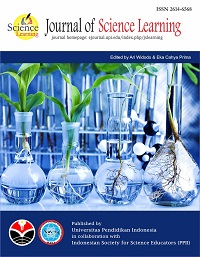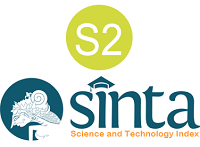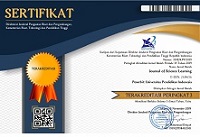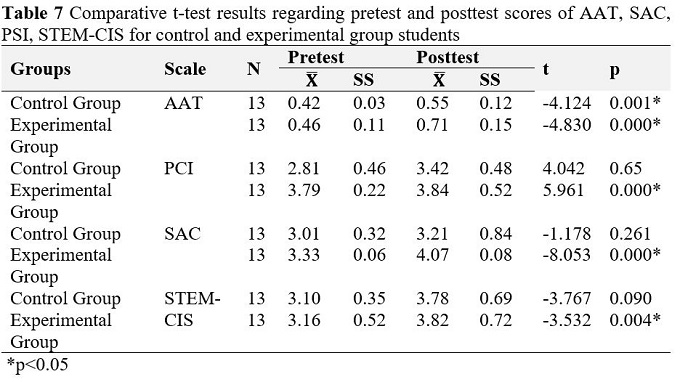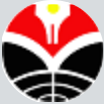Online Submissions
Already have a Username/Password for Journal of Science Learning?
Go to Login
Need a Username/Password?
Go to Registration
Registration and login are required to submit items online and to check the status of current submissions.
Submission Preparation Checklist
As part of the submission process, authors are required to check off their submission's compliance with all of the following items, and submissions may be returned to authors that do not adhere to these guidelines.
Author(s)’ Publication Ethics
Journal of Science Learning (JSL)
Author(s)’ Publication Ethics and Malpractice Statement
hereby declare that I/we accept and comply with Journal of Science Learning (JSL)’s publication ethics and publication malpractice statement.
I/we sent to JSL is my/our original work which is free from plagiarism and has not been published before either in printed or online and is not being sent to/reviewed by other publishers.
TRANSFER OF COPYRIGHT AGREEMENT
By clicking this agreement, authors agree transfering the copyright in case of the manuscript was accepted to be published in JSL.
The transfer of copyright from author to publisher must be clearly stated in writing to enable the publisher to assure maximum dissemination of the author’s work.
Parties of the Agreement
The manuscript is herewith submitted for publication in “Journal of Science Learning” (JSL)Subject of the Agreement
A) Copyright
- The Author and each co-authors transfer the copyright and grant the journal right of publication with the work simultaneously licensed under an International Creative Commons Attribution and ShareAlike 4.0 License that allows others to share the work with an acknowledgement of the work's authorship and initial publication in this journal.
- Authors are able to enter into separate, additional contractual arrangements for the non-exclusive distribution of the journal's published version of the work (e.g., post it to an institutional repository or publish it in a book), with an acknowledgement of its initial publication in this journal.
- The Author (Co-authors) guarantees that the Materials are an original work, submitted only to JSL, and have not been published previously.
- In case the Materials were written jointly with Co-authors, the Author guarantees that he/she has informed them of the terms of this Agreement and obtained their signatures or written permission to singe on their behalf.
- The Author guarantees as well that:
- The Materials do not contain libelous statements.
- The Materials do not infringe on other persons' rights (including without limitation copyrights, patent rights and the trademark right).
- The Materials do not contain facts or instructions that can cause damage or injury to third parties and their publication dose not cause the disclosure of any secret or confidential information
- Manuscripts submitted for publication in JSL should be between 4,000 and 10,000 WORDS and typed in double spacing including tables, figures, and references including references.
The ABSTRACT should maintain a maximum of 250 WORDS.
The manuscript has 25 REFERENCES for a minimum
JSL adopts the APA 6 rev. citation style.
Look https://www.ltu.se/cms_fs/1.78649!/file/APA_6th_ed.pdf for the detail information
All references mentioned in the Reference list are cited in the text, and vice versa
Multiple Authors for the Same Source
- One author: Smith (2007) or (Smith, 2007)
- Two authors: Smith and Thomas, (2007) or (Smith & Thomas, 2007)
- Three to five authors: Smith, Thomas, and Jones (2007)
Parenthetical citation: (Smith, Thomas, & Jones, 2007)
Subsequent parenthetical citations: (Smith, et al., 2007)
- Six or more authors: Smith et al. (2007)
Parenthetical citation: Smith et al., 2007)
Subsequent parenthetical citations: (Smith et al., 2007)
- Group authors: American Psychological Association (APA, 2010)
- Subsequent citations in text: (APA, 2010)
Parenthetical citation: American Psychological Association ([APA], 2010) Subsequent parenthetical citations: (APA, 2010)
For more information, see APA manual (6th ed.), p. 177.
All the references have been formatted following this style:
APA Styles Guideline for References
Book:
Author, F. M. (Year of Publication). Title of work. Publisher City, State: Publisher.
James, H. (2009). The ambassadors. Rockville, MD: Serenity.
Chapter in a Print Book:
Author, F. M. (Year of Publication). Title of chapter. In F. M. Editor (Ed.), Title of book (pp. xx-xx). Publisher City, State: Publisher.
Shuhua, L. (2007). The night of MidAutumn Festival. In J. S. M. Lau & H. Goldblatt (Eds.), The Columbia Anthology of Modern Chinese Literature (pp. 95-102). New York, NY: Columbia University Press.
E-Books:
Author, F. M. (Year of Publication). Title of work [E-reader version]. Retrieved from URL
Stoker, B. (2000). Dracula [Kindle HDX version]. Retrieved from http://www.overdrive.com/
Chapter in an E-book:
Author, F. M. (Year of Publication). Title of chapter. In F. M. Editor (Ed.), Title of book [E-reader version] (pp. xx-xx). Retrieved from URL or http://dx.doi.org/xxxx
Journals found on a database or online:
Author, F. M. (Year of Publication). Article title. Journal Title, Volume Number(Issue Number), pp.-pp. http://dx.doi.org/xxxx or Retrieved from homepage URL
Trier, J. (2007). “Cool” engagements with YouTube: Part 2. Journal of Adolescent & Adult Literacy, 50(7), 598-603. http://dx.doi.org/10.1598/JAAL.50.7.8
Journals found in print:
Author, F. M., Author, F. M. & Author, F. M. (Year of Publication). Article title. Journal Title, Volume(Issue Number), page range.
Lin, M.G., Hoffman, E.S., & Borengasser, C. (2013). Is social media too social for class? A case study of Twitter use. Tech Trends, 57(2), 39-45.
Magazine:
Last, F. M. (Date Published). Article title. Magazine Title, Volume(Issue), Page(s).
Website:
Last, F. M. (Date Published). Web page title. Retrieved from Homepage URL
Newspaper:
Last, F. M. (Year, Month Day published). Article title. Newspaper Title, Page(s).
Manuscript has been 'spell-checked' and 'grammar-checked' using word processing or Grammarly software.
There is no grammatical and typographycal errors- The active and passive sentences must be presented clearly.
- Checking the coordinating conjuction, subcoordinating conjunction, transitional expression.
- Checking the grammar rule of past tense, simple present, present perfect.
- Checking the grammar rule and style written english
- Permission has been obtained for use of copyrighted material from other sources (including the Internet)
Table Checklist
(Taken from the Publication Manual of the American Psychological Association, 7th ed., Section 7.20)
- Is the table necessary?
- Does it belong in the print and electronic versions of the article, or can it go in an online supplemental file?
- Are all comparable tables presented consistently?
- Are all tables numbered with Arabic numerals in the order they are mentioned in the text? Is the table number bold and left-aligned?
- Are all tables referred to in the text?
- Is the title brief but explanatory? Is it presented in italicized title case and left-aligned?
- Does every column have a column heading?
- Are all abbreviations; special use of italics, parentheses, and dashes; and special symbols explained?
- Are the notes organized according to the convention of general, specific, probability?
- Are table borders correctly used (top and bottom of table, beneath column headings, above table spanners)?
- Does the table use correct line spacing (double for the table number, title, and notes; single, one and a half, or double for the body)?
- Are entries in the left column left-aligned heading?
- Are confidence intervals reported for all major point estimates?
- Are all probability level values correctly identified, and are asterisks attached to the appropriate table entries? Is a probability level assigned the same number of asterisks in all the tables in the same document?
- If the table or its data are from another source, is the source properly cited? Is permission necessary to reproduce the table?
Please follow the JSL Table Example (Mandatory)Look the detail at
Figure Checklist
(Taken from the Publication Manual of the American Psychological Association, 7th ed., Section 7.35)
- Is the figure necessary?
- Does the figure belong in the print and electronic versions of the article, or is it supplemental?
- Is the figure simple, clean, and free of extraneous detail?
- Is the figure title descriptive of the content of the figure? Is it written in italic title case and left aligned?
- Are all elements of the figure clearly labeled?
- Are the magnitude, scale, and direction of grid elements clearly labeled?
- Are parallel figures or equally important figures prepared according to the same scale?
- Are the figures numbered consecutively with Arabic numerals? Is the figure number bold and left aligned?
- Has the figure been formatted properly? Is the font in the image portion of the figure and between sizes 8 and 14?
- Are all abbreviations and special symbols explained?
- If the figure has a legend, does it appear within or below the image? Are the legend’s words written in title case?
- Are the figure notes in general, specific, and probability order? Are they double-spaced, left aligned, and in the same font as the paper?
- Are all figures mentioned in the text?
- Has written permission for print and electronic reuse been obtained? Is proper credit given in the figure caption?
- Have all substantive modifications to photographic images been disclosed?
- Are the figures being submitted in a file format acceptable to the publisher?
- Have the files been produced at a sufficiently high resolution to allow for accurate reproduction?
Please follow the JSL Figure example (Mandatory)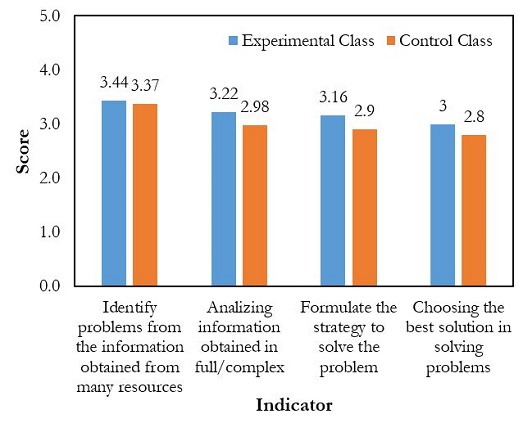
Look the detail at
DISCUSSION PART must be SEPARATED from Conclusion. The manuscript without the conclusion part will not be processed.
The manuscript Must Contain CONCLUSION part.
- The manuscript submission contains at least ONE FIGURE representing the flow or mechanism of the research. The author is REQUESTED to provide the GRAPHICAL ABSTRACT with the size 670 x 500 pixels to be presented on the front page of the article on the website. The Graphical Abstract can be attached to the SUPPLEMENTARY INFORMATION.
State within 100 words regarding your manuscript's novelty and your research contribution to the latest development of technology-integrated science learning, media, assessment, or curriculum.
- If you are from the university (Staff of Students), the affiliation must contain Department, Faculty, University, City, Country.
The author is REQUESTED to recommend 5 (FIVE), international peer reviewers, during the submission.
WE WILL NOT PROCESS THE MANUSCRIPT SUBMISSION WITHOUT REVIEWER RECOMMENDATION ATTACHED IN THE SUPPLEMENTARY FILE OR COMMENT FOR EDITOR
Please list the names in the COMMENT FOR EDITOR below containing
1. Reviewer Names
2. Institutions, Countries
3. Emails
4. Reasons
By clicking this form, the authors declared that the reviewers have been suggested to JSL with no conflicts of interest. JSL has the authority to choose the suggested reviewers based on the Editor
In order to extend the JSL international authorship, the first author from Indonesia are REQUESTED to invite the international co-author out of Indonesian. If you have an international colleague, please invite him/her to be a part of co-authors, as long as he/she is under the research's expertise with his/her contribution and acceptance.
For better corespondence, Please add also the WHATS'APP PHONE NUMBER in comment's to Editor Below
Privacy Statement
The names and email addresses entered in this journal site will be used exclusively for the stated purposes of this journal and will not be made available for any other purpose or to any other party.






